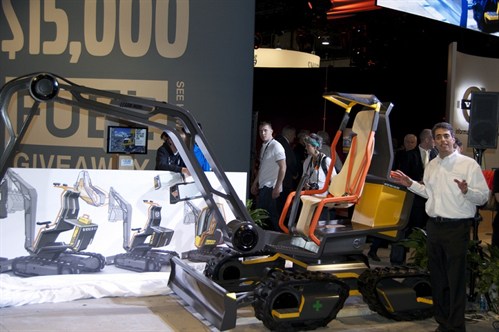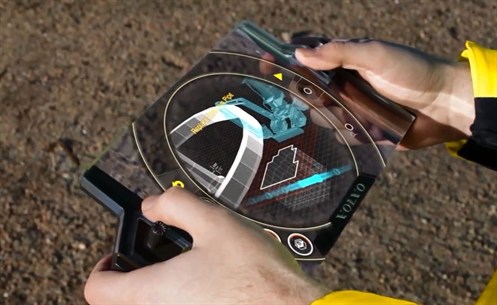Volvo Construction Equipment had its eyes set firmly in the future with its fully electric compact excavator design- using Swedish furniture and high tech features.
A life-size model of the concept, named GaiaX, was revealed at the 2014 CONEXPO-CON/AGG construction expo in Las Vegas last month.
Watch the video by Volvo CE North America at the show
A prominent distinction of the GaiaX’s design compared to traditional excavators is plenty of ‘air’ in the design, making it minimalistic yet functional. Lightweight steel guard rails have been put in place of a cab, and a three-dimensional Swedish designed molded wood will act as the operator’s seat.
With the GaiaX, Volvo CE says operators can also carry out most applications remotely using an augmented reality tablet computer.
According to Volvo CE, the concept was based on the company’s previous concept machines – the Sfin (excavator), Centaur (hauler), Gryphin (wheel loader) and Fenix (paver). It also draws from Greek mythology and is inspired by the primordial deity Gaia – the creator and mother of Earth and the universe.
“The Mother Earth figure embodies many characteristics of the concept compact excavator – its innate affinity with the ground, its power, strength, and all-seeing control, as well as its protective qualities,” says Volvo CE design director Stina Nilimaa Wickstrom.
“This is a machine, designed to work in harmony with nature, with minimal environmental impact, and that cares for the user and site staff, keeping them safe from harm.”
“Like Gaia, the excavator is also the first of a generation – and of exceptional beauty.”
She adds the GaiaX concept aims to place the user right at the heart of the machine.
“It should be easy, almost effortless to operate, providing the ultimate in comfort, efficiency, productivity – and safety.”
In the design, Volvo CE turned the usual disadvantage of a heavy battery to an advantage by using it as a counterweight to the arm and boom.
Four electrically-powered tracks provide good ground surface contact and ensure stability and manoeuvrability.
The rechargeable batteries are designed to see the operator through a whole working day – but the GaiaX can be used while plugged into an external electrical power source.
Volvo Product Design chief designer Sidney Levy says this ability allows the machine to be used in city environments or even in buildings where power sources are readily available.
He says GaiaX’s zero emissions and silent movement also allows it to be used in urban areas.
“We have learnt ta lot in trying to make the GaiaX as simple and efficient as possible – some elements of which will be able to be applied to our machines in the future,” he says.
Safety is also a huge part of the GaiaX’s design – with built-in warning sensors alerting operators of approaching passers-by , and an airbag which inflates from the seat to shield the operator from collisions or falling objects.
Given its minimalistic design, Levy says the human-machine interface (HMI) on the GaiaX is highly advanced.
“The GaiaX project has been an incredible opportunity for us to experiment with the way construction equipment is used – we feel as if we are paving the way to the future of Volvo and perhaps the industry too,” he says.
Operators can still sit on the excavator in a traditional way – required for precise movements and transport, but most applications can be carried out remotely using an augmented reality tablet computer.
Volvo CE says the main benefit of this transparent iPad-like device is that only one person is required to use the machine – the operator can dig and keep an eye on the surrounding environment at the same time.
Remote operation also allows the machine to be used in potentially dangerous situations.
The augmented reality tablet will be mapped with the city’s utility systems, showing the exact location of water pipes and electrical cables on screen and allowing the operator to visualise the work before it is carried out.
The tablet also connects to other machines in the fleet to provide a more effective way of working.
The interface suggests the most economical and ecologically friendly way to complete the work but will give the user the option of entering new requirements related to the task.
Another highlight of the concept is the operator’s seat- which Volvo CE says is a tribute to another one of Sweden’s national specialties – furniture design.
Award-winning Swedish furniture designer Monica Förster designed the seat, formed from three-dimensional molded wood that exudes Swedish beauty and simplicity.
“Our design team attended a conference with Monica Förster last year and we were so excited by her design process that we wanted to apply it to one of our machines,” Levy adds.
However, customers might have to wait till 2030 for the machine to be fully operational.
Click here to find Volvo excavators for sale.



